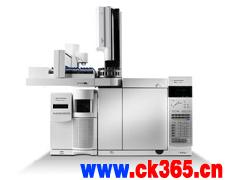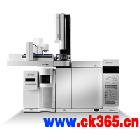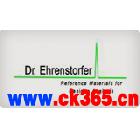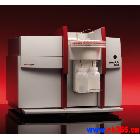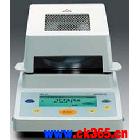| Agilent 7890A/5975C 气-质联用仪 |
| 产品描述: |
5975C MSD DetailsBuilt on a solid foundation of industry leadership, reliability and performance, the Agilent 5975C Series GC/MSD with the Triple-Axis Detector incorporates significant product enhancements to improve analytical performance and take your lab to the next level of productivity. High temperature, solid inert ion source boost productivity The proprietary inert source fulfills three fundamental requirements. Inertness minimizes loss of active, neutral molecules from the GC. High temperature (350 ˚C) supports excellent peak shapes even for high boiling compounds and minimizes contamination from high boiling matrices. A novel lens element extends into the quadrupole to optimally transfer ions into the center of the RF/DC field for the highest S/N in the industry. Gold standard quadrupole design and performance The unique quadrupole has unsurpassed performance and reliability. This true hyperbolic quartz structure will give lower field errors, better resolution and superb mass axis stability, regardless of operating temperature. In fact, the remarkable stability of the monolithic quartz allows analyzer temperatures up to 200 ˚C to ensures analyzer cleanliness throughout the life of the MSD. Triple-Axis Detector The triple-axis orientation places the HED-EM doubly off-axis from the axis of the transmission quadrupole. This evolutionary change allows ion collection to be maximized (increased signal) and neutral noise to be reduced below off-axis detector designs. The detector also introduces a triple-channel multiplier with increased amplification and longer life. Agilent’s Gain Normalized optimization of the EM ensures the optimal balance between ion count, linearity and EM life expectancy. Furthermore, Gain Normalization means consistent sensitivity during the aging of the EM and consistent ion counts between multiple GC/MSD systems. Trace Ion Detection and the second generation of Deconvolution Reporting Software (DRS) delivers a real performance improvement for trace analysis in complex matrices Trace Ion Detection digitally filters noise from baselines, peaks and spectra to improve detection with or without DRS. For coelution problems found in the most complex samples, the deconvolution power of NIST AMDIS is the ultimate tool for trace analysis by GC/MS. After deconvolution, “cleaned” spectra provide better library search results, and quantification based upon deconvoluted peaks reduces the errors in MS target ions. The ChemStation fully integrates AMDIS results into QEdit and report functions so the analyst can quickly compare standard and deconvoluted results. With Trace Ion Detection and DRS, method detection limits (MDL) and limits of quantitation (LOQ) are lower. False positives and false negatives are reduced for the highest confidence in the data. High-Performance Selected Ion Monitoring (SIM) and Full Scan Synchronous SIM/Scan functionality captures SIM data and full scan data in the same acquisition, with no compromise in analytical performance. SIM dwell times can be set in from over 100 msec to 1 msec in 1 msec increments. AutoSIM automatically converts scan data into SIM or SIM/scan acquisition parameters—saving setup time for methods with many peaks. Capillary Flow Technologies that improve productivity, lower costs and increase analytical power 5th generation EPC with inert, low-mass, low-dead volume devices and leak-free, in-oven connections have created numerous GC configurations that enhance capabilities and performance. For GC/MS analyses of complex samples with late eluting matrix peaks, backflush is an essential tool. Shorter analyses, less source cleaning and longer column life are valuable benefits for any laboratory. Capillary splitters and Deans switching simplify and improve the reliability of complementary detection schemes such as MSD-ECD and heart-cutting methods. With ChemStation control, these functions can be used as routinely as the simplest GC/MSD method. GC/MS software helps you make the most of every run, and every workday Agilent MSD Productivity ChemStation software makes it easy even for non-expert operators to take advantage of all the power of the Agilent 5975C GC/MSD. Advanced capabilities include: Control of two GC/MS systems from a single MSD ChemStation Integrated control of the versatile CTC PAL autosamplers can boost your lab’s output with automated sample preparation (available option). Retention Time Locking (RTL) gives you repeatable retention times across systems regardless of operator, detector type and column maintenance. In combination with Agilent or user-created databases, it will let you quickly screen unknown peaks with added confidence. Automatic tuning to ensure more accurate results every time for EI, PCI and NCI Modes. SemiQuant capability to estimate the concentration of uncalibrated compounds. Integration with Enterprise Content Management (ECM) makes it easy to store, retrieve and organize all of the electronic data generated in your laboratory – including your GC/MSD files and reports.Maintenance and Reliability Features Modular analyzer assembly offers complete access to the filament ion source, and electron multiplier for faster routine maintenance. Front glass window provides simple source identification, as well as a complete view of critical connections. High-reliability vacuum system assures maximum long-term performance; available oil-free pumping systems virtually eliminate pump maintenance, reduce noise, and can be used with corrosive gases such as ammonia. The complete 5975C lineup with the Triple-Axis Detector includes: 5975C VL MSD — Economical, small-footprint system for routine analyses 5975C inert MSD — High performance, full-featured system for demanding analyses 5975C inert XL MSD — High performance, full-featured system optimized for complex EI analyses 5975C inert XL EI/CI MSD — Highest level of GC/MS performance and productivity available
主要特点: |
- 广州优瓦仪器有限公司 [加为商友]

- 联系人陈志东(先生) 经理
- 地区北京
- 地址广东省广州市越秀区东风西路132号之二903室




